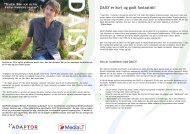Geodata tilpasset GPS for synshemmede (PDF) - MediaLT
Geodata tilpasset GPS for synshemmede (PDF) - MediaLT
Geodata tilpasset GPS for synshemmede (PDF) - MediaLT
Create successful ePaper yourself
Turn your PDF publications into a flip-book with our unique Google optimized e-Paper software.
Når man er fotgjenger, kan det også være et problem at de kartene som brukes, er laget <strong>for</strong><br />
bilnavigasjon. Det begynner å komme in<strong>for</strong>masjon spesielt beregnet <strong>for</strong> fotgjengere, men det<br />
mangler mye på dette området. Man kan f.eks. ikke regne med at gågater, gangveier eller veier<br />
gjennom parker er med på kartet. Mange småveier inne i boligområder mangler også (Ulland ,<br />
2010, s. 9).<br />
At kartene ikke er laget <strong>for</strong> fotgjengere er også noe som beskrives i rapporten A geographical in<strong>for</strong>mation<br />
system <strong>for</strong> a <strong>GPS</strong> based personal guidance system fra 1998. I rapporten som beskriver prosessen å lage et<br />
geografisk in<strong>for</strong>masjonssystem (GIS) <strong>for</strong> blinde, kommer det frem at flesteparten av de eksisterende<br />
kartdatabasene har blitt laget uten å ta hensyn til behovene til de blinde (Golledge et al., 1998, s. 745). GIS<br />
er "....programvare <strong>for</strong> innsamling, organisering, lagring, analyse og presentasjon av geografisk stedfestet<br />
in<strong>for</strong>masjon" (Store norske leksikon, 2012).<br />
I utdraget under beskrives geodata og tilleggsin<strong>for</strong>masjon som manglet i databasene. Eksempler på dette<br />
var blant annet <strong>for</strong>tau, stier, in<strong>for</strong>masjon om lyskryss, gangfelt ,in<strong>for</strong>masjon om trafikken, om trafikken går<br />
én eller begge veier og om endring i teksturen i underlaget.<br />
Missing features are features such as the presence or absence of sidewalks, paths (e.g across a<br />
park area), or trails (e.g through a recreational area). There usually is no indication as whether<br />
or not a street has bike paths along its edges nor are the widths of roads and the number of<br />
traffic lanes given. Other missing features include whether the traffic is one way or two way,<br />
whether there is a central divider or pedestrian island, whether there are curb cuts facilitating<br />
entry into the street (see Hauger et a. 1996, <strong>for</strong> an evaluation of just how effective these are),<br />
whether traffic lights or other control system - such as stop signs and pedestrian crossings -<br />
exist at a corner, whether traffic is allowed to make u-turns (often a significant importance<br />
when trying to cross a divided roadway). Environmental features often used by blind travellers<br />
to estimate distance travelled include fire hydrants and telephone poles (Whose regular<br />
spacing provide the blind traveller with a way of estimating distance travelled). Most existing<br />
databases do not indicate changes in texture of the surface being covered or on either side of<br />
it. All these features can be used by the blind traveller to estimate distances travelled, to help<br />
ensure safety when crossing streets or roadways, to obtain shelter during inclement wether, or<br />
to simply to allow shorelining to take place. (Shorelining involves using a continuous edge such<br />
as a wall, a curb, or a change in surface texture such as the edge of a paved path, to guide one<br />
11




